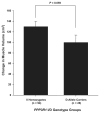Influence of promoter region variants of insulin-like growth factor pathway genes on the strength-training response of muscle phenotypes in older adults
- PMID: 17761791
- PMCID: PMC2811278
- DOI: 10.1152/japplphysiol.00420.2007
Influence of promoter region variants of insulin-like growth factor pathway genes on the strength-training response of muscle phenotypes in older adults
Abstract
To examine the influence of insulin-like growth factor (IGF) pathway gene polymorphisms on muscle mass and strength responses to strength training (ST), we studied 128 White and Black men and women before and after a 10-wk single-leg knee extension ST program. One-repetition maximum strength, muscle volume (MV) via computed tomography, and muscle quality (MQ) were assessed at baseline and after 10 wk of ST. There was a significant combined IGF1 cytosine adenine (CA) repeat gene effect, which included both the IGF1 CA repeat main effect and IGF1 CA repeat x PPP3R1 insertion-deletion (I/D) gene x gene interaction effect, on the changes in strength (P < 0.01) and MQ (P < 0.05) with ST. There was a trend for a significant gene x gene interaction between IGF1 CA repeat and PPP3R1 I/D for changes in strength (P = 0.07) and MQ (P = 0.06) with ST. The influence of the PPP3R1 A-202C gene polymorphism on change in MV with ST approached significance (P = 0.06). The IGF1 CA repeat polymorphism had a significant influence on the change in strength and MV combined with ST (P < 0.05), whereas the influence of the PPP3R1 I/D polymorphism approached significance (P = 0.08). There were no associations between the IGFBP3 A-202C gene polymorphism and the muscle phenotypic responses to ST. These data suggest that two of the three IGF pathway gene polymorphisms identified in this study influence muscle phenotypic responses to ST in both black and white older men and women.
Figures




Similar articles
-
Muscle strength response to strength training is influenced by insulin-like growth factor 1 genotype in older adults.J Appl Physiol (1985). 2005 Jun;98(6):2147-54. doi: 10.1152/japplphysiol.00817.2004. J Appl Physiol (1985). 2005. PMID: 15894537 Clinical Trial.
-
A polymorphism near IGF1 is associated with body composition and muscle function in women from the Health, Aging, and Body Composition Study.Eur J Appl Physiol. 2010 Sep;110(2):315-24. doi: 10.1007/s00421-010-1500-0. Epub 2010 May 19. Eur J Appl Physiol. 2010. PMID: 20490824 Free PMC article.
-
Does insulin-like growth factor 1 genotype influence muscle power response to strength training in older men and women?Eur J Appl Physiol. 2012 Feb;112(2):743-53. doi: 10.1007/s00421-011-2028-7. Epub 2011 Jun 11. Eur J Appl Physiol. 2012. PMID: 21667186
-
Predictors of variation in serum IGF1 and IGFBP3 levels in healthy African American and white men.J Natl Med Assoc. 2009 Jul;101(7):711-6. doi: 10.1016/s0027-9684(15)30981-0. J Natl Med Assoc. 2009. PMID: 19634593 Free PMC article.
-
Microsatellite polymorphism in the P1 promoter region of the IGF‑1 gene is associated with endometrial cancer.Mol Med Rep. 2016 Jun;13(6):4950-8. doi: 10.3892/mmr.2016.5181. Epub 2016 Apr 25. Mol Med Rep. 2016. PMID: 27121258 Free PMC article.
Cited by
-
Effects of exercise and milk fat globule membrane (MFGM) supplementation on body composition, physical function, and hematological parameters in community-dwelling frail Japanese women: a randomized double blind, placebo-controlled, follow-up trial.PLoS One. 2015 Feb 6;10(2):e0116256. doi: 10.1371/journal.pone.0116256. eCollection 2015. PLoS One. 2015. PMID: 25659147 Free PMC article. Clinical Trial.
-
CNTF 1357 G -> A polymorphism and the muscle strength response to resistance training.J Appl Physiol (1985). 2009 Oct;107(4):1235-40. doi: 10.1152/japplphysiol.90835.2008. Epub 2009 Jul 23. J Appl Physiol (1985). 2009. PMID: 19628720 Free PMC article.
-
Analysis of cytosine-adenine repeats in P1 promoter region of IGF-1 gene in peripheral blood cells and cervical tissue samples of females with cervical intraepithelial lesions and squamous cervical cancer.Mol Med Rep. 2015 Feb;11(2):766-74. doi: 10.3892/mmr.2014.2916. Epub 2014 Nov 10. Mol Med Rep. 2015. PMID: 25384883 Free PMC article.
-
Association of regular aerobic exercises and neuromuscular junction variants with incidence of frailty: an analysis of the Chinese Longitudinal Health and Longevity Survey.J Cachexia Sarcopenia Muscle. 2021 Apr;12(2):350-357. doi: 10.1002/jcsm.12658. Epub 2021 Feb 1. J Cachexia Sarcopenia Muscle. 2021. PMID: 33527771 Free PMC article.
-
Beyond Calories: Individual Metabolic and Hormonal Adaptations Driving Variability in Weight Management-A State-of-the-Art Narrative Review.Int J Mol Sci. 2024 Dec 15;25(24):13438. doi: 10.3390/ijms252413438. Int J Mol Sci. 2024. PMID: 39769203 Free PMC article. Review.
References
-
- Baxter RC, Martin JL, Beniac VA. High molecular weight insulin-like growth factor binding protein complex. J Biol Chem. 1989;264:11843–11848. - PubMed
-
- Clarkson PM, Devaney JM, Gordish-Dressman H, Thompson PD, Hubal MJ, Urso M, Price TB, Angelopoulos TJ, Gordon PM, Moyna NM, Pescatello LS, Visich PS, Zoeller RF, Seip RL, Hoffman EP. ACTN3 genotype is associated with increases in muscle strength in response to resistance training in women. J Appl Physiol. 2005;99:154–163. - PubMed
-
- Deal C, Ma J, Wilkin F, Paquette J, Rozen F, Ge B, Hudson T, Stampfer M, Pollak M. Novel promoter polymorphism in insulin-like growth factor-binding protein-3: correlation with serum levels and interaction with known regulators. J Clin Endocrinol Metab. 2001;86:1274–1280. - PubMed
-
- Delmonico MJ, Kostek MC, Doldo NA, Hand BD, Bailey JA, Rabon-Stith KM, Carignan C, Hurley BF. Effects of moderate velocity strength training on peak muscle power and movement velocity: do women respond differently from men? J Appl Physiol. 2005;99:1712–1718. - PubMed
Publication types
MeSH terms
Substances
Grants and funding
LinkOut - more resources
Full Text Sources
Medical
Miscellaneous

